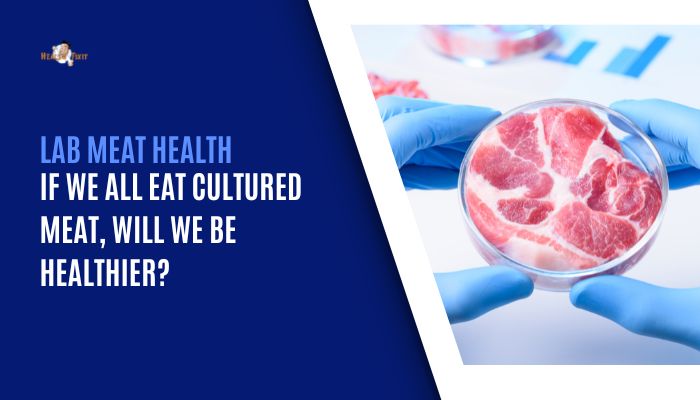Introduction
As concerns about animal welfare, environmental impact, and antibiotic use rise, lab-grown (cultured) meat—produced by cultivating animal cells in bioreactors—offers an alternative to traditional livestock
. But what about its nutritional value and overall impact on human health? While touted as “cleaner” and more sustainable,
many questions remain: Could cultured meat reduce cholesterol issues? Does it lack important micronutrients? This article unpacks health considerations around lab-based meats,
offering insights into whether a widespread shift to “cellular agriculture” might make us collectively healthier—or if we should temper our expectations.
How Cultured Meat Is Made
Cell Extraction and Growth
Producers obtain stem cells or muscle cells from a living animal via biopsy. These cells go into a nutrient-rich medium—containing growth factors, amino acids, vitamins—within bioreactors. The environment mimics conditions in the animal’s body, allowing cells to proliferate.
Tissue Formation
Over time, cells assemble into muscle-like fibers. Some companies use scaffolds (like plant-based materials) to support the 3D structure resembling real meat. Others create ground-meat analogs first, focusing on shape or texture later.
End Product
The result can be cultured ground beef, chicken pieces, or fish fillets. Flavorings, color additives, or texture enhancements might then be applied to approximate conventional cuts. Although initial versions were pricey, costs are declining as technology scales.
Nutritional Profile
Protein Quality
Cultured meat typically has a comparable amino acid profile to its conventional counterpart—since it originates from the same muscle cells. So, in theory, it should deliver complete proteins, essential for muscle and tissue maintenance.
Fat Content and Composition
Producers can adjust fat levels by controlling cell types or adding lipids. Some labs experiment with healthier fat compositions, e.g., higher omega-3 fatty acids. This customization may yield “designer meats” that reduce heart disease risk compared to factory-farmed meats.
Micronutrients
Traditional meat contains iron, zinc, B vitamins. Cultured versions can include these if the growth medium is fortified.
However, achieving consistent levels is an ongoing challenge—ensuring, for example, heme iron’s bioavailability. Further R&D aims to match or exceed conventional meat’s micronutrient density.
Health Benefits Potential
Reduced Exposure to Antibiotics
Conventional livestock farming uses large amounts of antibiotics, contributing to antibiotic-resistant bacteria. Cultured meat circumvents the need for prophylactic antibiotics, lowering the chance of antibiotic residues or resistant strains entering the food chain.
Less Bacterial Contamination
Meat from slaughtered animals can carry pathogens like E. coli or Salmonella from the gut or environment. Lab meat is grown in sterile conditions—ideally reducing contamination risks, though strict QA/QC remains essential.
Customizable Composition
By modulating growth conditions, cultured meat might be enriched with beneficial fats or reduced in cholesterol. This “tailoring” could help fight chronic ailments like cardiovascular disease if widely adopted.
Caveats and Considerations
Processing and Additives
Current prototypes often rely on growth media or flavor enhancers that might not be 100% organic or natural. Some mediums contain fetal bovine serum—though alternatives are emerging. Additional binders or flavorings might raise concerns over processed content.
Unknown Long-Term Effects
Lab-grown meat has short commercial history. We lack extensive data on its long-term health impact. Thorough testing is needed to confirm safety, digestibility, and the fate of any novel proteins or growth-factor residues.
Nutritional Gaps
If not properly formulated, cultured meat could miss certain micronutrients or produce less familiar nutrient forms. Ongoing scientific validation is essential to ensure we’re not losing crucial vitamins or minerals present in conventional meats.
Broader Health Context
Environmental and Social Health
Reduced greenhouse gas emissions and land usage could yield a positive macro effect—cleaner air,
fewer antibiotic-resistant microbes, potentially less climate-driven health crises. This indirect benefit, while not personal health per se, fosters healthier societies.
Variety in Diet
Even if cultivated meat is “healthier” than factory-farmed meat, a balanced diet remains key. Overreliance on any single food source can limit nutrient diversity. Combining lab meat with fruits, vegetables, whole grains, and other proteins ensures a well-rounded nutritional intake.
Psychological Acceptance
Taste, texture, and mental acceptance are big factors. If large swaths of consumers remain skeptical or find the product “unnatural,” lab meat might remain niche. Overcoming stigma requires demonstration of consistent quality and a consumer trust built on transparency.
The Road to Widespread Adoption
Scale and Cost Reduction
Early lab meat commanded sky-high prices. As processes scale, production costs should fall. Achieving price parity with conventional meat is crucial for mass adoption—only then might the majority switch, reaping potential health benefits at scale.
Regulatory Approval
Authorities (like the FDA, EFSA etc.) want robust safety data—covering potential allergens, nutritional equivalence, and labeling standards. Clear regulations and transparent labeling about how the meat was grown fosters consumer trust.
Consumer Education
Clear messaging about environmental, ethical, and health advantages is key to shift perceptions.
Demystifying the science behind cultured meat—ensuring it’s not seen as “Frankenfood”—helps acceptance. Trials, taste tests, and consistent results will help build public confidence.
Conclusion
Lab-grown meat—as it evolves—could offer a more controlled, potentially healthier alternative to traditional meat.
By tailoring fat profiles, minimizing contamination, and eliminating antibiotic misuse, cultured meat stands to reduce diet-related health risks. However,
bridging the gap between theoretical benefits and real-world outcomes hinges on factors like manufacturing scale, cost,
taste, nutritional completeness, and public trust. While it’s no universal panacea, and a balanced diet remains paramount,
the arrival of viable, large-scale cultured meat could steer many societies toward a cleaner, ethically sound, and possibly healthier protein source in the not-too-distant future.
References
- Post MJ. Cultured meat from stem cells: challenges and prospects. Meat Sci. 2019;153:7–15.
- Hocquette JF. Is in vitro meat the solution for the future? Meat Sci. 2016;120:167–176.
- Chriki S, Hocquette JF. The myth of cultured meat: a review. Front Nutr. 2020;7:7.
- Tuomisto HL, Teixeira de Mattos MJ. Environmental impacts of cultured meat production. Environ Sci Technol. 2011;45(14):6117–6123.
- Gerling P, Wilks M, et al. Consumer acceptance of in vitro meat: the case for health-driven motivations. Appetite. 2021;157:105016.
- Zambrano F, Schaefer G, et al. Nutritional and health aspects of cultured meat. Trends Food Sci Technol. 2022;128:211–224.
- Stephens N, et al. Bringing cultured meat to market: technical, socio-political, and regulatory challenges. Trends Food Sci Technol. 2018;78:155–166.
- Rubio NR, Xiang N, Kaplan DL. Plant-based and cell-cultured meat for the future. Protein Sci. 2020;29(8):1222–1238.
- Bryant CJ, Barnett J. Consumer acceptance of cultured meat: a systematic review. Meat Sci. 2018;143:8–17.
- Neumann L, Erian K, Reichardt J, Metzger M, Pogrzeba M. Key factors shaping consumer acceptance of cultured meat. Front Vet Sci. 2021;8:660967.


